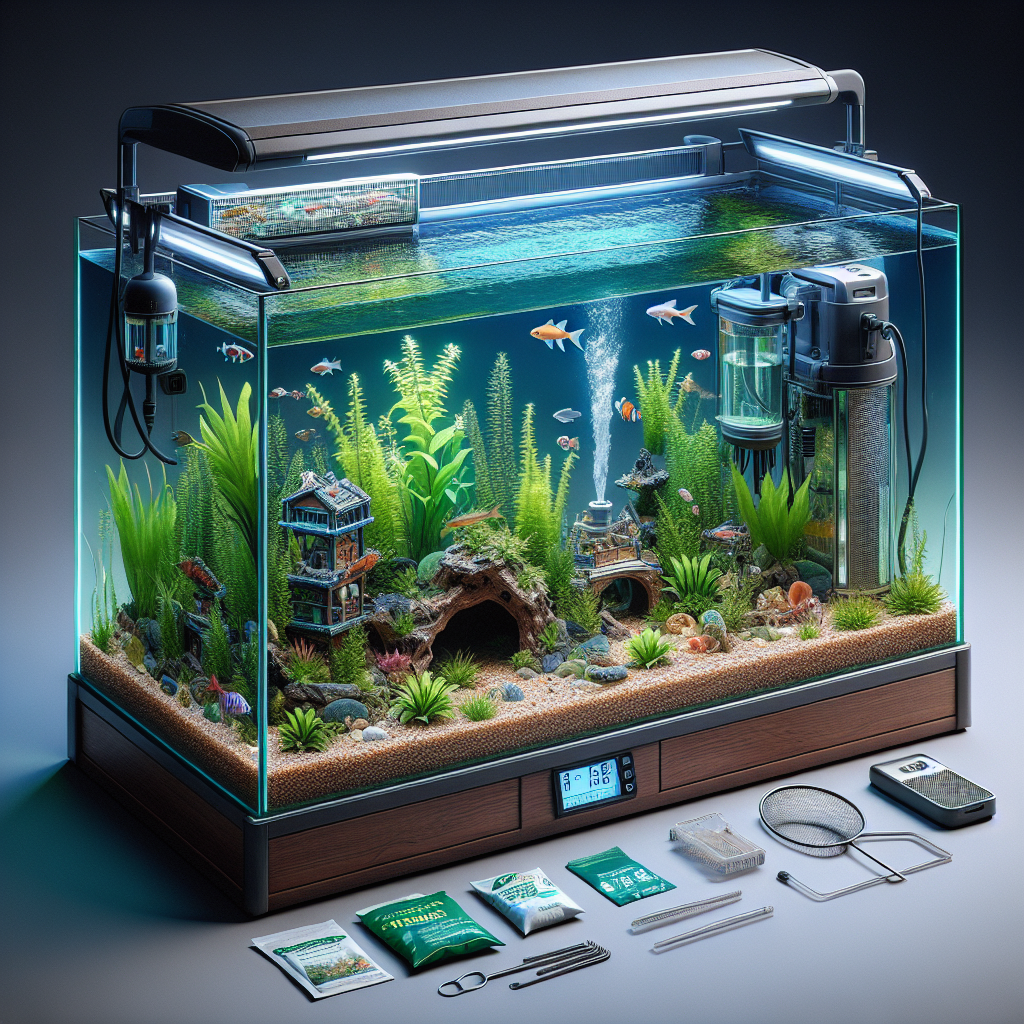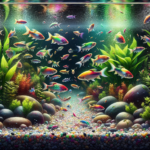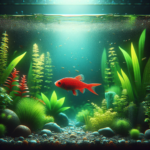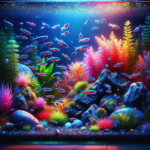
Key Takeaways
-
A 20-gallon tank with an LED light, power filter, and heater is a solid starting point for beginners.
-
Always rinse substrates before adding them to your tank to prevent cloudiness.
-
Quality water testing kits are crucial for maintaining a healthy aquatic environment.
-
Choose low-maintenance plants and fish to create a self-sustaining ecosystem.
-
Personalize your setup with decorations and accessories that suit your style.
Embarking on Your Freshwater Journey: Essential Kit Components
When you’re ready to dive into the world of aquariums, it’s like setting sail on a grand adventure. You want to ensure your vessel is shipshape, which means starting with the right components. Let’s make sure you have everything you need for a smooth voyage into aquatic bliss.
Finding the Perfect Tank Size for Your Space and Ambition
Size matters when it comes to aquariums. A good rule of thumb for beginners is to start with a 20-gallon tank. This size is manageable, provides enough room for fish to thrive, and fits well in most spaces. Here’s why it’s a smart choice:
-
It’s large enough to maintain stable water conditions, which is crucial for the health of your fish.
-
There’s ample space to add a few decorations and plants, creating an environment that’s visually appealing and comfortable for your fish.
-
A 20-gallon tank is also small enough to clean easily and doesn’t require a significant financial investment.
Remember, the bigger the tank, the more maintenance it might need, but it also allows for more creativity and diversity in your aquatic setup.
Filtering Through the Options: Choosing a Quality Water Filtration System
A top-notch filtration system is the heart of your aquarium. It keeps the water crystal clear and free of harmful substances. There are three types of filtration: mechanical, chemical, and biological. For a balanced ecosystem, you’ll want a filter that does all three.
Most importantly, make sure the filter is rated for the size of your tank or even slightly larger. This ensures it can handle the volume of water and the bioload, which is the amount of waste your fish and plants produce.
-
A power filter that hangs on the back of the tank is a great choice for beginners because it’s easy to install and maintain.
-
Canister filters are another option for those looking for a more advanced setup. They’re powerful and can be hidden away, but they require a bit more work to clean.
Because a good filtration system is critical, don’t skimp on quality. It’s the key to a healthy aquarium and less work for you in the long run.
Shedding Light on Your Aquatic Paradise: A Guide to Aquarium Lighting
Lighting is not just for showcasing your underwater masterpiece; it’s essential for plant growth and the well-being of your fish. LED lights are your best bet—they’re energy-efficient, have a long lifespan, and many offer a spectrum of colors to simulate natural daylight cycles.
-
Look for lights with adjustable settings so you can create the perfect ambiance for your tank’s inhabitants.
-
For planted tanks, ensure the light you choose supports plant photosynthesis.
Keep in mind that too much light can lead to algae growth, so it’s all about finding the right balance.
Turning up the Heat: Selecting an Aquarium Heater
Stable water temperature is vital for the health of your fish. A submersible heater is a reliable way to maintain the warmth your aquatic friends need. Choose a heater with a thermostat to easily control the temperature and make sure it’s suitable for the size of your tank.
-
A 100-watt heater is typically sufficient for a 20-gallon tank.
-
Always have a good quality thermometer to monitor the temperature. It’s a small investment that goes a long way in preventing temperature-related stress on your fish.
Remember, some fish require specific temperature ranges, so do your research before bringing them home.
Setting the Scene with Substrates and Decorations
The substrate is the foundation of your aquarium’s landscape. It supports plant life and contributes to the biological filtration process. Choose a high-quality, nutrient-rich substrate specifically designed for planted tanks.
-
Rinse the substrate thoroughly before adding it to your tank to avoid clouding the water.
-
Select decorations that not only look great but also provide hiding places for your fish, which is important for their sense of security.
As you set the stage with substrates and decorations, think about the natural habitats of your fish and try to mimic those conditions. It’ll make them feel right at home!
Advancing with Advanced Kits: When It’s Time to Upgrade
After you’ve gotten your fins wet with a beginner kit, you might find yourself yearning for more. Advanced kits come with a whole ocean of possibilities, allowing for greater customization and complexity in your aquatic ecosystem.
Understanding the Enhanced Features of Advanced Kits
Advanced aquarium kits offer features that cater to hobbyists looking to expand their aquatic horizons. These kits often include upgraded filtration systems, more sophisticated lighting options with programmable features, and larger tank sizes that can accommodate a wider variety of fish and plants.
-
More powerful filters that can handle increased bioloads, often necessary for larger tanks or more populated aquariums.
-
LED lighting systems with a broader spectrum and customization options for simulating sunrise and sunset, which can promote better health and more natural behavior in fish.
-
Heaters with more precise temperature controls and sometimes even built-in redundancy to prevent failure.
As you grow in your fishkeeping journey, these enhanced features will not only make maintenance easier but also open up new possibilities for stocking and aquascaping.
From Novice to Hobbyist: Transitioning to a Complex Setup
Transitioning from a beginner to an advanced aquarium setup is like upgrading from a rowboat to a sailboat—you’ll have more control and it’s a bit more complex, but the journey is richer. This transition involves learning about water chemistry, the nitrogen cycle, and the specific needs of more diverse and often more delicate aquatic life.
Therefore, before you make the leap, ensure you’re ready for the commitment. Upgraded kits can require more time and knowledge to maintain, but the rewards are well worth the effort. A thriving, diverse aquarium is a stunning sight and a testament to your dedication to the hobby.
Customizing Your Creation: When a Kit Isn’t Enough
Sometimes, the path to creating your underwater utopia requires going beyond what a standard kit can offer. Customization is the key to tailoring your aquarium to your vision.
Adding a Personal Touch: Accessories to Enhance Your Aquascape
From the serene to the spectacular, accessories can transform your aquarium. Consider the following to elevate your aquascape:
-
Natural driftwood and rocks can create a stunning, biotope-like environment.
-
Backgrounds that give your tank depth and hide unsightly cords or equipment.
-
Diverse plant species that vary in color, texture, and height for a dynamic layout.
Besides that, you can introduce more advanced equipment, like CO2 injection systems for plant growth or wave makers to simulate natural water currents.
DIY Tips and Tricks for Personalizing Your Freshwater Aquarium
When you’re ready to get creative, DIY projects can add a unique touch to your tank. Try building your own aquarium stand or creating a custom backdrop using non-toxic paints and materials. Remember, whatever you add to your tank, it’s important to ensure it’s safe for your aquatic friends.
DIY Aquarium: Save Money or Go Premium?
With so many options out there, it can be a tidal wave of information. Let’s navigate the waters of the DIY aquarium scene and compare some of the top contenders.
The Balance of Quality and Cost: An Honest Look at Affordable Kits
Affordable kits are a great way to enter the world of aquariums without breaking the bank. They typically include the basics—tank, filter, and lighting—which is enough to get you started. However, the cost can often reflect the quality of the components. Affordable kits may have less durable materials or less powerful equipment, so it’s important to consider the long-term investment.
Aquarium Kits on the Premium End: Are They Worth It?
-
Premium kits often come with higher-grade materials, such as thicker glass or acrylic, which can better withstand wear and tear.
-
The filtration systems and lights in premium kits are usually more advanced, offering better performance and longevity.
-
Many premium kits include additional features like built-in timers for lights or smart technology integration for monitoring your tank’s conditions.
While the initial cost is higher, premium kits can offer better value over time with less need for upgrades or replacements.
Making an Informed Decision: Features to Compare
When comparing aquarium kits, look at the following features to make an informed decision:
-
Tank size and material—consider the space you have and the durability you need.
-
Filter capacity—make sure it’s rated for your tank size and the amount of life it will support.
-
Lighting quality—look for adjustable settings and the right spectrum for your plants and fish.
-
Heater accuracy—temperature stability is key, so find a heater with good reviews and reliable performance.
Remember, the best kit is one that fits your needs, your budget, and your level of experience.
Keeping Your Aquatic Ecosystem Thriving
Maintaining a healthy aquarium is a rewarding part of the hobby. Regular upkeep is essential, but it doesn’t have to be a chore. With the right routine, you can ensure your aquatic ecosystem continues to flourish.
Maintenance Mastery: Routine Upkeep for Your DIY Aquarium
Consistency is key when it comes to aquarium maintenance. Here’s a quick checklist to help you stay on track:
-
Weekly water tests to monitor pH, ammonia, nitrites, and nitrates.
-
Partial water changes—about 20-25%—every two weeks to keep water quality high.
-
Regular filter maintenance, including rinsing or replacing media as needed.
-
Checking and adjusting the temperature and lighting settings to mimic natural conditions.
By keeping a close eye on these elements, you’ll be well on your way to creating a self-sustaining slice of aquatic life that brings you joy every day.
Dealing with Algae and Common Aquarium Challenges
Even the most well-maintained aquariums can face challenges, and algae is one of the most common. It’s not all bad—some algae growth is natural and can even be beneficial, providing food for some fish and invertebrates. But when it gets out of hand, it can cloud your water and cover your decorations, turning your beautiful display into a murky mess.
To combat algae:
-
Limit the amount of light your aquarium receives. Too much light encourages algae growth, so aim for about 8-10 hours of light per day.
-
Keep nutrients in the water low by performing regular water changes and avoiding overfeeding your fish.
-
Consider adding algae-eating fish or snails to your community, which can naturally help control algae levels.
Other common issues include cloudy water, which can be a result of overfeeding, lack of filtration, or bacterial blooms. Regular maintenance and monitoring can usually prevent or resolve these problems.
FAQs: Your Questions Answered
How Often Should I Test the Water in My DIY Aquarium?
You should test the water in your aquarium at least once a week to ensure it remains safe for your fish. Keep an eye on pH levels, ammonia, nitrite, and nitrate. Sudden changes in these parameters can stress or even kill your aquatic pets, so it’s crucial to catch and address any issues early.
Can I Mix Different Types of Freshwater Fish in My Aquarium?
Yes, you can mix different types of freshwater fish, but it’s important to do your research. Some fish require different water conditions, and not all species get along. Look for community fish that thrive in similar conditions and have compatible temperaments to ensure a peaceful tank.
Is It Possible to Over-filter an Aquarium?
While it’s difficult to over-filter an aquarium, it’s possible to have too much water flow, which can stress some fish. Choose a filter rated for your tank size, and if you notice your fish struggling against the current, look for ways to redirect or lessen the flow.
What Are Some Common Mistakes Beginners Make with DIY Aquarium Kits?
Beginners often make the mistake of rushing the setup process. It’s essential to take the time to cycle the tank properly before adding fish. Overstocking the tank, overfeeding, and neglecting regular maintenance are also common pitfalls that can lead to unhealthy aquarium conditions.
How Can I Tell if My Aquarium Plants Are Healthy?
Healthy aquarium plants are vibrant in color, free from brown spots, and show new growth. If your plants are looking a little lackluster, they may need more light, nutrients, or CO2. Regular pruning and proper positioning can also help ensure your plants thrive.
Remember, a thriving aquarium is a balance of the right equipment, a well-chosen community of fish and plants, and regular maintenance. With patience and attention to detail, you can create a stunning aquatic environment that’s both a joy to watch and a comfortable home for your aquatic friends.




